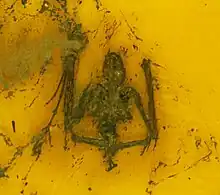Archaeonycteris
Archaeonycteris is an archaic bat genus whose fossilised remains have been found in Germany, France, England and India.
| Archaeonycteris Temporal range: Early-Middle Eocene | |
|---|---|
 | |
| Scientific classification | |
| Domain: | Eukaryota |
| Kingdom: | Animalia |
| Phylum: | Chordata |
| Class: | Mammalia |
| Order: | Chiroptera |
| Family: | †Archaeonycteridae |
| Genus: | †Archaeonycteris Revilliod, 1917 |
| Species | |
|
see text | |
The genus was established in 1917, when Pierre Revilliod described the material excavated at the Messel Pit as the fossil species Archaeonycteris trigonodon.
- Archaeonycteris trigonodon Revilliod, 1917 - Messel Pit (Lutetian), Germany[1]
- Archaeonycteris pollex Storch & Habersetzer, 1988 - Messel Pit (Lutetian), Germany[2]
- Archaeonycteris brailloni Russell et al., 1973 - Avenay quarry (Ypresian), France[3]
- Archaeonycteris relicta Harrison & Hooker, 2010 - Creechbarrow Limestone Formation, England[4]
- Archaeonycteris storchi Smith et al., 2007 - Vastan Lignite Mines (Ypresian), India[5]
A species discovered at the Silveirinha site in Portugal, Archaeonycteris praecursor, was described in 2009 and estimated to be the oldest of the known taxa. The fossil material uncovered in Dorset, England, and described as Archaeonycteris relicta is dated to a later period in the Eocene, this is the most recent known species. The only species to found beyond Europe is the Early Eocene fossil species Archaeonycteris storchi, which occurs in India.[6]

Archaeonycteris trigonodon
References
- Revilliod, P. (1917). "Contribution à l'étude des chiroptères des terrains tertiares". Abhandlungen der Schweizerischen Paläontologischen Gesellschaft. 42: 1–57.
- Storch, G.; Habersetzer, J. (1988). "Archaeonycteris pollex (Mammalia: Chiroptera) eine neue Fledermaus aus dem Eozän der Grube Messel bei Darmstadt". Courier Forschungsinstitut Senckenberg. 107: 263–273.
- D. E. Russell; P. Louis; D. E. Savage (1973). "Chiroptera and Dermoptera of the French early Eocene". University of California Publications in Geological Sciences. 95: 1–57.
- Harrison, D. L.; Hooker, J. J. (2010). "Late Middle Eocene bats from the Creechbarrow Limestone Formation, Dorset, southern England with description of a new species of Archaeonycteris (Chiroptera: Archaeonycteridae)". Acta Chiropterologica. 12 (1): 1–18. doi:10.3161/150811010X504554. S2CID 84965106.
- Smith, T.; Rana, R.S.; Missiaen, P.; Rose, K.D.; Sahni, A.; Singh, H.; Singh, L. (2007). "High bat (Chiroptera) diversity in the Early Eocene of India". Naturwissenschaften. 94 (12): 1003–1009. Bibcode:2007NW.....94.1003S. doi:10.1007/s00114-007-0280-9. hdl:1854/LU-385394. PMID 17671774. S2CID 12568128.
- Gunnell, Gregg F.; Simmons, Nancy B. (2012). Evolutionary History of Bats: Fossils, Molecules and Morphology. Cambridge University Press. pp. 34–37. ISBN 9781107376823.
This article is issued from Wikipedia. The text is licensed under Creative Commons - Attribution - Sharealike. Additional terms may apply for the media files.